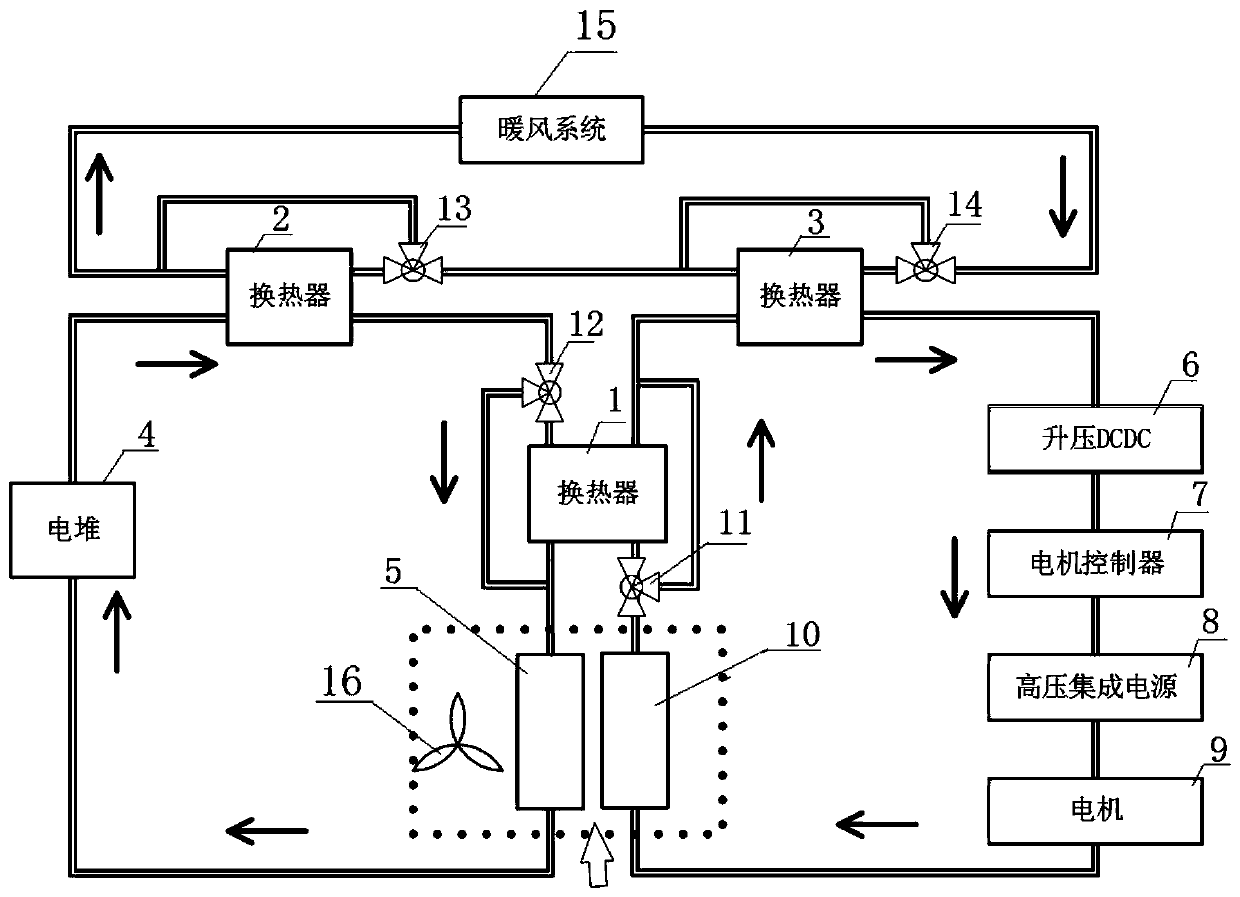Fuel cell vehicle low-power-consumption multi-factor coupling heat radiation system and method
A heat dissipation system and fuel cell technology, applied in the direction of fuel cell heat exchange, fuel cells, fuel cell additives, etc., can solve problems such as energy loss and complex structure, and achieve the effect of effective heat utilization and maximum fan energy utilization
- Summary
- Abstract
- Description
- Claims
- Application Information
AI Technical Summary
Problems solved by technology
Method used
Image
Examples
Embodiment 1
[0030] In order to overcome the complex structure of the existing heat dissipation system, the serious energy loss, and the lack of good utilization of the heat energy of the entire system, this embodiment provides a low-power multi-coupled heat dissipation system for fuel cell vehicles, which uses a single set of fans and double heat dissipation The heat exchanger structure replaces the original single fan and single radiator structure to maximize the energy utilization of the fan; by adding heat exchangers to the heat dissipation system of the electric stack cooling system and the cooling system of high-voltage components such as motors and motor controllers, the low temperature environment is realized. Use the heat of high-voltage components such as motors and motor controllers to preheat the stack; add heat exchangers between the cooling system of the stack, the cooling system of high-voltage components such as motors and motor controllers, and the heating system in the car ...
Embodiment 2
[0046] This embodiment provides a working method of a fuel cell vehicle low-power multi-coupled coupling cooling system. The method is implemented based on the fuel cell vehicle low-power multi-coupled cooling system described in Embodiment 1. The method includes the following steps:
[0047] S1, control the conduction of the first three-way solenoid valve 11 and the second three-way solenoid valve 12, the step-up DC / DC converter 6, the motor controller 7, the high-voltage integrated power supply 8 and the motor 9 are generated during the operation of the series connection The heat energy is input into the first heat exchanger 1 through the radiator, and the heat energy exchanged by the first heat exchanger 1 is transmitted to the fuel cell stack 4 through the radiator to preheat the fuel cell stack 4 .
[0048] S2, control the conduction of the third three-way solenoid valve 13 and the fourth three-way solenoid valve 14, the heat generated by the fuel cell stack 4 passes throu...
Embodiment 3
[0050] This embodiment provides an electric vehicle. The electric vehicle includes a fuel cell vehicle low-power multi-coupled cooling system and a warm air system. Heat exchange is performed between the fuel cell vehicle low-power multiple coupled cooling system and the warm air system.
[0051] For the specific structure of the fuel cell vehicle low-power multi-coupled cooling system of this embodiment, please refer to the relevant descriptions of the previous embodiments, and details are not repeated here.
PUM
 Login to View More
Login to View More Abstract
Description
Claims
Application Information
 Login to View More
Login to View More - R&D
- Intellectual Property
- Life Sciences
- Materials
- Tech Scout
- Unparalleled Data Quality
- Higher Quality Content
- 60% Fewer Hallucinations
Browse by: Latest US Patents, China's latest patents, Technical Efficacy Thesaurus, Application Domain, Technology Topic, Popular Technical Reports.
© 2025 PatSnap. All rights reserved.Legal|Privacy policy|Modern Slavery Act Transparency Statement|Sitemap|About US| Contact US: help@patsnap.com

